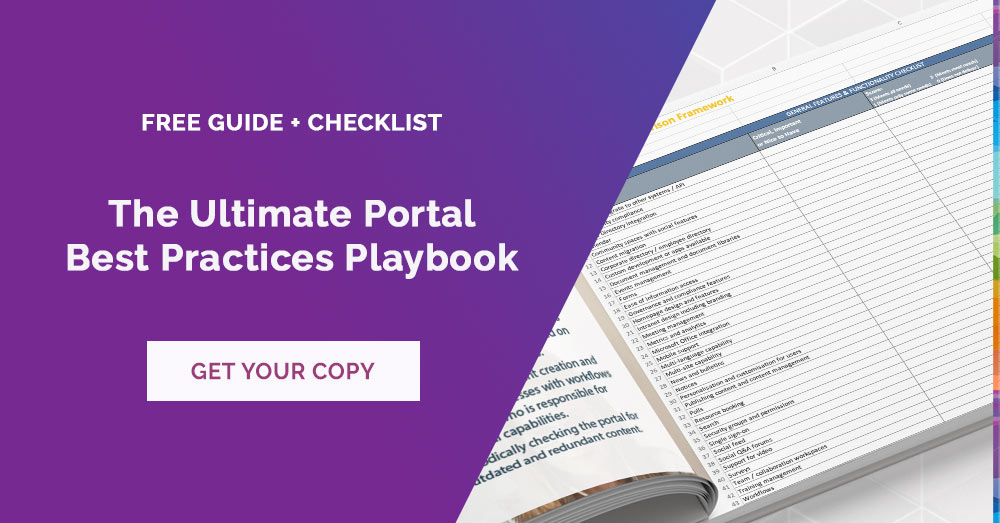It’s said that around 40% of web portal initiatives fail to get off the ground with the adoption rates required to achieve ROI. So why do so many portals become underutilised or forgotten?
Quite often it comes from:
- A lack of personalisation/relevancy
- A lack of understanding of how it helps over existing processes
- A lack of excitement over the new solution.
We’ve compiled five important ways to give life to your portal’s launch and beyond, based on successful enterprise portal implementations.
Personalise the Portal Experience
A modern web CMS portal will enable detailed content personalisation for all end users, whether they be employees, contractors, students, parents, members, customers, dealers, suppliers, board members or any other stakeholder.
Portal content and structures can be tailored in a number of ways, including customised news, calendar events, menu items and navigation, and content itself.
You might personalise portal experiences based on previous behaviour within the portal such as top viewed pages or documents. For example, Vita Group, a publicly listed leading Australian retailer, added in live search on their redesigned intranet. This feature pulls in the top 4 articles team members in similar roles within a user’s business area have looked at over the past 14 days and presents those to users as 4 buttons beneath the search bar. This is self-updating and has led to employees searching less for the information they need.
You might also use your CMS enterprise portal to deliver highly customised email marketing or messaging to specific groups of users, which can be invaluable whether you’re seeking donations for your not-for-profit or a boost in ticket sales for your next event.
Integrate Relevant Third Party Solutions
Each organisation and its needs are unique. As such, yours will likely have an ecosystem of tools that support your everyday operations and are relevant to your industry or team – these might include Microsoft 365, Salesforce and SAML, as well as industry specific platforms such as Synergetic Management, a information management system for school, or CommunityCRM, a NFP CRM solution.
Ascham School, for example, have deeply integrated their school portal, the Hub, with Synergetic Management, and push more of their data into the Hub. For example, each student's medical form is pre-populated with information pulled from Synergetic. When updated, a workflow is triggered and a notification is sent to staff for approval. Once approved, it is updated back into Synergetic. This integration makes it much easier for students and parents to perform several different actions the school requires of them, from one easy-to-use interface.
Flexibility with integration is key to ensuring that stakeholders will find your new portal invaluable. Find a portal CMS that easily integrates with the most common third party solutions, with access to a free developer API for custom solutions.
Through effective integration, you’ll be able to pull in valuable data from all of your solutions and access everything with just one set of log-in credentials. It’s a huge time saver and delivers a seamless all-in-one experience to employees.
Build Anticipation
The months and weeks building up to your portal launch should be spent building excitement about the benefits it will bring for each user group.
One strategy is to launch a competition for future users to name the new system.
You could advertise through various media channels such as email marketing, posters and newsletters, depending on your user types, and to drop feed features ahead of time.
You might wish to hold a launch party for your new portal system with branded giveaways. Following launch, you could offer a giveaway or discount that can only be accessed through the new portal to inspire active use.
Further reading: [Blog Post] Proven Intranet Launch Ideas to Increase Engagement
Provide Training and Guidance
A good CMS web portal will come with several features and capabilities, and will have some level of learning curve, but you can minimise this learning curve with a well-structured system and with training and guidance. You might set up an interactive tour of the new portal as soon as they log in.
For employees, you might provide in-person training in conjunction with your CMS provider to help them adapt to the new system. Consider having 'lunch and learn' session(s). This involves hosting in-person training, ideally during lunch to avoid disrupting their days.
As you launch, you could announce a treasure hunt with elements hidden through your portal or knowledge base to encourage people to explore the system in its entirety.
On a related note, you could also offer online training capabilities via your portal to ensure it is a valuable resource for your end users. Training is important for your workforce but also as a service for your customers with potential to generate revenue. A web CMS that has the capability to deliver courses via your portal makes the business case even more compelling.
Make the Most of Metrics
Your opportunity to optimise adoption rates for your CMS online portal doesn’t end at launch – rather, there are ongoing opportunities to improve usability and appeal to the portal’s end users.
Your CMS should allow you to access key metrics such as the popularity of specific pages, how people search for and find information and how often certain features are put to use. This will provide true insights into where you should be focusing attention next; whether that’s adding fresh and interesting content, additional functionality through integration or retraining for an underused feature of the portal.
With regular assessment before, during and following the launch of your web portal, you’ll be able to demonstrate success to key stakeholders and get the best return possible for your investment.
For more insights on portals, we recommend you check out the 'Portal Best Practices Playbook'.

Further reading: